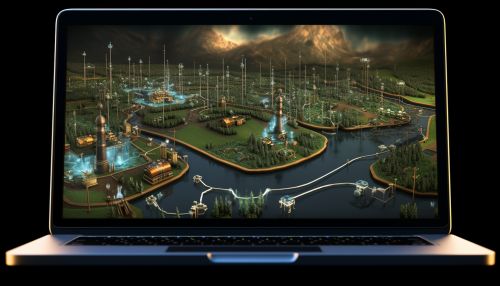Hydroinformatics
Overview
Hydroinformatics is a branch of informatics that focuses on the application of information technology to water and environmental engineering. It combines elements of data science, computational hydraulics, and environmental engineering to develop efficient methods for managing water resources. The field has grown significantly over the past few decades, with advancements in technology enabling more sophisticated modeling and analysis of water systems.


History of Hydroinformatics
The term "hydroinformatics" was first coined in the late 1980s, as researchers began to recognize the potential of information technology in managing water resources. The field has its roots in the broader discipline of hydraulic engineering, which involves the study of fluid mechanics and its applications in areas such as water supply, flood control, and irrigation.
The advent of modern computing technology in the mid-20th century provided a new set of tools for hydraulic engineers. The ability to model complex water systems digitally opened up new possibilities for research and practical applications. Over time, this led to the development of hydroinformatics as a distinct discipline.
Principles of Hydroinformatics
Hydroinformatics is based on a number of key principles. These include the use of mathematical models to represent water systems, the application of computational methods to solve these models, and the use of data analysis techniques to interpret the results.
One of the main goals of hydroinformatics is to develop efficient methods for managing water resources. This involves creating models that accurately represent the behavior of water systems, and using these models to predict the impact of different management strategies. These models can be used to optimize the allocation of water resources, minimize the impact of floods and droughts, and improve the quality of water supplies.
Mathematical Modeling in Hydroinformatics
Mathematical modeling is a fundamental aspect of hydroinformatics. These models are used to represent the behavior of water systems, and can be used to predict the impact of different management strategies.
There are many different types of models used in hydroinformatics, ranging from simple linear models to complex non-linear models. These models can represent a wide range of water systems, including rivers, lakes, groundwater aquifers, and water distribution networks.
The development of these models involves a combination of theoretical analysis and empirical data. Theoretical analysis is used to derive the mathematical equations that govern the behavior of the water system, while empirical data is used to calibrate and validate these models.
Computational Methods in Hydroinformatics
Computational methods play a crucial role in hydroinformatics. These methods are used to solve the mathematical models that represent water systems, and to analyze the results of these models.
There are many different computational methods used in hydroinformatics, ranging from simple numerical methods to sophisticated machine learning algorithms. These methods can be used to solve a wide range of problems, including the optimization of water resources, the prediction of flood and drought events, and the analysis of water quality data.
The choice of computational method depends on the specific problem at hand, as well as the characteristics of the water system being modeled. In general, the goal is to choose a method that provides accurate results, while also being computationally efficient.
Data Analysis in Hydroinformatics
Data analysis is another key aspect of hydroinformatics. This involves the use of statistical techniques to interpret the results of mathematical models, and to extract useful information from large datasets.
There are many different data analysis techniques used in hydroinformatics, ranging from simple descriptive statistics to complex multivariate analysis. These techniques can be used to identify patterns and trends in water data, to test the validity of mathematical models, and to make predictions about future events.
The advent of big data technologies has opened up new possibilities for data analysis in hydroinformatics. These technologies allow researchers to process and analyze large volumes of data, enabling more sophisticated analysis and more accurate predictions.
Applications of Hydroinformatics
Hydroinformatics has a wide range of applications in water and environmental engineering. These include the management of water resources, the prediction of flood and drought events, the design of water distribution networks, and the analysis of water quality data.
One of the main applications of hydroinformatics is in the management of water resources. This involves the use of mathematical models and computational methods to optimize the allocation of water resources, and to minimize the impact of floods and droughts.
Another important application of hydroinformatics is in the design of water distribution networks. These networks are complex systems that require careful planning and management. Hydroinformatics provides the tools necessary to design these networks efficiently, and to ensure that they operate effectively under a wide range of conditions.
Hydroinformatics is also used in the analysis of water quality data. This involves the use of data analysis techniques to identify patterns and trends in water quality data, and to predict the impact of different management strategies on water quality.
Future Directions in Hydroinformatics
The field of hydroinformatics is constantly evolving, with new technologies and methods being developed all the time. Some of the key areas of future research in hydroinformatics include the development of more sophisticated mathematical models, the application of machine learning techniques to water data, and the integration of big data technologies into hydroinformatics research.
One of the main challenges in hydroinformatics is the development of more sophisticated mathematical models. These models need to accurately represent the behavior of water systems, and to be able to predict the impact of different management strategies. This requires a deep understanding of the physical processes involved in water systems, as well as the ability to represent these processes mathematically.
Another key area of future research in hydroinformatics is the application of machine learning techniques to water data. Machine learning provides a powerful set of tools for analyzing large volumes of data, and can be used to make accurate predictions about future events. The integration of machine learning techniques into hydroinformatics research could lead to significant advancements in the field.
The advent of big data technologies has opened up new possibilities for hydroinformatics research. These technologies allow researchers to process and analyze large volumes of data, enabling more sophisticated analysis and more accurate predictions. The integration of big data technologies into hydroinformatics research is a key area of future research.
